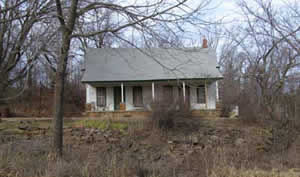Properties associated with the Native Americans who occupied present-day Oklahoma from earliest times or who were moved to Indian Territory in the nineteenth century are among Oklahoma’s most important historic resources. Of Oklahoma’s twenty-two National Historic Landmarks (NHL), thirteen of them are associated with these groups. Among the twelve Oklahoma NHL’s designated before passage of the National Historic Preservation Act are the Cherokee National Capitol, Fort Gibson (associated with the end of the Cherokee’s Trail of Tears and federal government relations with the tribe), and Sequoyah’s Cabin; and the George M. Murrell House, home of a prominent Cherokee leader, was designated an NHL in 1974. The OK State Historic Preservation Office (OK SHPO) nominated Native American properties to the National Register of Historic Places from the beginning of the program and continues to do so today including recently successfully nominating four additional properties associated with the Cherokee Trail of Tears. The following nominations were made possible through a cooperative agreement between the National Park Service (NPS), National Trails Intermountain Region and the OK SHPO.
Cherokee Trail of Tears Properties Added to National Register of Historic Places
—
1 minute




